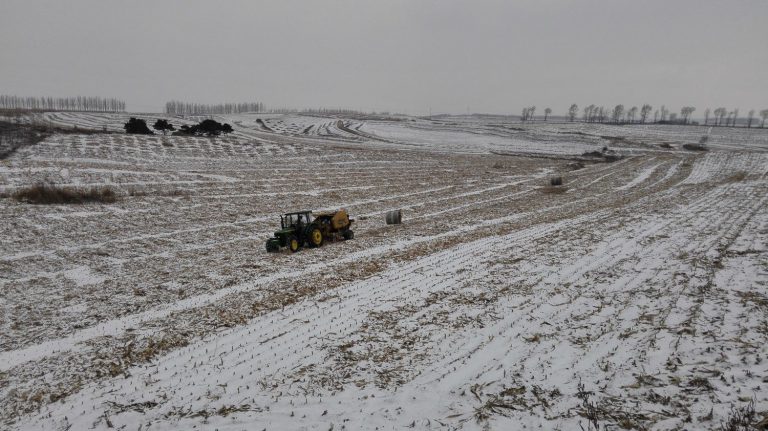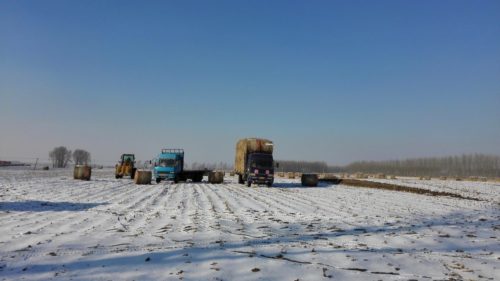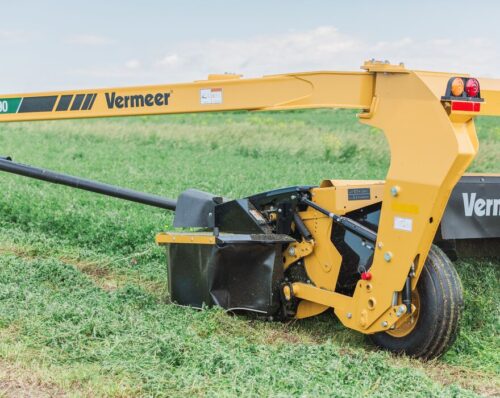
Big Plans for Biomass
June 2016
Humid summers. Frigid winters. Black, fertile soil. And rolling hills that flatten into miles of corn, wheat and soybeans.
Midwesterners might think this to be an accurate description of the land they were born and raised on, when in fact it also speaks of a land 7,200 miles away where farmers in China also enjoy a continental climate, rich soil and a society rooted in agriculture.
Here in the three northeastern provinces of China — Heilongjiang, Jilin and Liaoning — people are making efforts to use cleaner energy with the resources already available to them.
Shawn Wang, Vermeer Corporation associate product manager, works with producers in China and the Vermeer dealership in China (known as Vermeer Tianjin Manufacturing or VTM) to adopt mechanical crop residue harvesting methods.
“Traditionally, people have had a hard time getting rid of cornstalks,” Wang said. “In the past, (the stalks) were hand-harvested. Farmers would pick the ears of corn and leave the stalks standing. Then someone would come into the field and hand-cut the stalks, laying them perpendicular to the rows.”
Wang said that after the cornstalks were cut, farmers would arrange them into bundles — usually 10 or so per acre — and light each bundle on fire. Others would leave the stalks lying flat and set fire to the entire field.
“Even though mechanized farming methods have been brought into the area and combines shred stalks and spread material onto the field, how to get rid of the cornstalk residue is still a question,” Wang said.

Today, burning practices are not used as frequently, but there are still many farmers who use this method to get rid of stalks, and it’s causing issues for other locals.
“When people burn the stalks like this it causes very low visibility on highways,” Wang explained. “Every year, you hear about it causing multiple-car pile-ups.”
Traffic problems are not the only concern caused by the burning of cornstalks.
According to Chinese authorities, last year from November 1 to November 3, there were a total of 702 fields set on fire in the three northeastern provinces, which caused air pollution levels to rise 40 times higher than national air quality standards.
To compound the issue, China has historically relied on coal for energy. Due to this and other factors, Wang said that China is facing pressure to alleviate air pollution.
As part of measures to lessen pollution, the country is trying to use fewer fossil fuels and make energy utilization more efficient. Many smaller coal power plants are being shut down and the production of a large number of biomass power plants is ongoing. According to the central government’s plan, China’s biomass electricity capacity will reach 30 million kilowatts by 2020.
“The northern region of China is one of the first regions to own and operate biomass power plants,” Wang said. “Depending on the type of material being used, a typical 24-megawatt plant can burn roughly 1,000 metric tons of material every day. And a well-managed plant can run close to 300 days a year.”
"Today, burning practices are not used as frequently, but there are still many farmers who use this method."
With an average-sized plant requiring 300,000 metric tons of material a year, it takes more material than one farmer can provide to keep plants well-stocked with biomass material. Thankfully, farmers in the area have a surplus of cornstalks and other organic material they’re trying to get rid of.
“Each biomass plant usually collects material from a 100 kilometer (60 mile) radius,” Wang said. “The plants burn a lot of wood waste — things like sawdust, tree roots, tree bark and demolition wood — in addition to rice husks, peanut shells, straw and cornstalks.”
In order for the feedstock to be properly fed to the boiler and burned at the maximum efficiency, materials need to be processed to a certain size, anywhere from 2 to 6 inches long, depending on the boiler type and in-feed system design.
To help biomass power plants prepare bio-waste to be converted to electricity, there are many Vermeer brush chippers, horizontal grinders and tub grinders hard at work. Before that stage, Vermeer 404 PRO balers are often baling 24 hours a day, seven days a week, in order to supply these power plants with enough clean, renewable fuel.
“Many operators run two 12-hour shifts,” Wang explained. “Even though that can create a high-stress situation, the advantage of the 404 PRO is that it is so dependable and easy to operate. Operators seldom have plugging issues, so they don’t need to get out of the cab in the evening in the harsh environment. They can just keep looking forward and keep baling.”
The typical season for cornstalk baling starts mid to late October and is usually over by the end of December. Wang explained that in the northern region of China, temperatures can get as low as -20 to -40 degrees Fahrenheit (-30 to -40 degrees Celsius) at night. Not only can it be extremely cold there, but it can also be very dirty.
“It’s an extremely dusty environment,” Wang said. “Which I think shows the durability of the 404 PRO and the toughness of it in extreme conditions.”

When operators aren’t baling in the dust, they’re often baling in the snow. Even with the challenges this can present, Wang says that it’s not uncommon for a well-trained operator to bale 800 bales a day.
It’s features like the extra wide pickup, chopper, rollers and a fixed chamber that Wang said allow the 404 PRO to tackle these tough jobs.
“High capacity rakes are not very popular in the area yet,” Wang said. “A lot of fields are raked by small wheel rakes, dumped by the combine or even hand-harvested and laid in rows. The windrows are not well controlled, so a narrow pickup won’t pick everything up.”
Wang said that when they first began working in the region, many power plant boilers and feeders had issues feeding long stalks, but this isn’t an issue anymore thanks to the pre-cutter system on the 404 PRO, which uses extra-long knives to cut material to the correct size for biomass boilers.
Using a baler that produces 4-by-4-foot bales is also an important and intentional decision. With the large round baling concept still being new to China, Wang said there are not many options to cheaply and efficiently handle bales. However, with the 404 PRO, operators in the region can produce bales that are easier to manage and move.
The transition to a mechanized harvest of crop residue is just beginning. Although the days of burning cornstalks may not yet be over, the future is still bright for biomass.
“I think it’s extremely important to reduce air pollution and to change the energy consumption structure,” Wang said. “Utilizing biomass is a great way to improve the environment, and it’s also a good way to generate income for farmers. It improves quality of life for both farmers and city residents, and we are pretty proud to be part of this journey. I think it’s only going to get bigger from here.”













